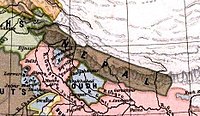Naya Muluk
This article includes a list of general references, but it lacks sufficient corresponding inline citations. (October 2022) |
| History of Nepal |
|---|
 |
|
|

Naya Muluk (Nepali: नयाँ मुलुक) is a geographical region of Nepal, which is situated western-south part in Nepal. The Terai land between Kali River to Rapti River called "Naya Muluk" after 1860.[1][2]
History
[edit]After Anglo-Nepalese War in 1814–1816, Nepal was forced to sign a treaty called Sugauli Treaty in which Nepal lost one third part of geographical territory. The geographical territory was sectioned in five parts as below:
- The whole of the lowlands between the Rivers Kali and Rapti.
- The whole of the low lands lying between the Rapti and the Gunduck.
- The whole of the lowlands between the Gunduck and Coosah.
- All the low lands between the Rivers Mitchee and the Teestah.
- All the territories within the hills east of the River Mitchee and all territories west of Kali.
Section: 2 and 3 (whole land from Rapti to Gundak and Gandak to Koshi) restored back to Nepal on December 11, 1816.
Section: 1 (whole low land between the Rivers Kali and Rapti) returned in 1860 called Naya Muluk.
Territory
[edit]
Naya muluk contains two district of Sudurpashchim province and two district of Lumbini Province. Total area is 9,207 square kilometres (3,555 sq mi) and total population is 2144,846.
| Districts | Area (KM2) | Population |
|---|---|---|
| Kanchanpur | 1,610 | 451,248 |
| Kailali | 3,235 | 775,709 |
| Bardia | 2,025 | 426,576 |
| Banke | 2,337 | 491,313 |
References
[edit]- ^ "Using 'Shikar Diplomacy' in 19th-Century Nepal". Retrieved 29 February 2020.
... what was then called 'Naya Muluk', a strip of Terai flatlands the British had returned to Nepal in gratitude in 1860 and today encompassing the districts of Kailali, Banke, Bardiya and Kanchanpur.
- ^ "International Boundary Survey and Demarcation of South-eastern portion of Nepal with India" (PDF). Retrieved 29 February 2020.
External links
[edit]- A map by survey of India of 1934 showing Naya Mulk
- https://www.spotlightnepal.com/2018/11/13/centenary-end-first-world-war-celebrations-all-over-world-except-nepal/
- http://himalaya.socanth.cam.ac.uk/collections/journals/contributions/pdf/CNAS_02_01_13.pdf
- Nationalism and Ethnic Conflict in Nepal: Identities and Mobilization After 1990
- https://www.tandfonline.com/doi/abs/10.1080/09700160802309233
- Raja Pratap Vikram Shah vs Kr. Upendra Bahadur Shah And Ors. on 15 September, 1951
